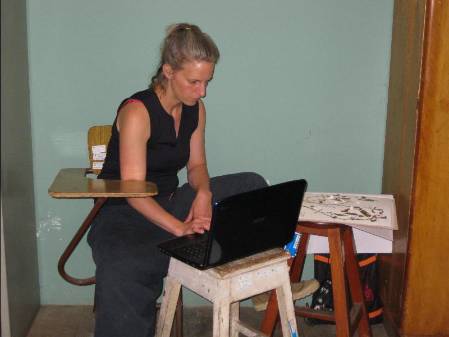Today we spent the day databasing specimens in the local Trujillo herbarium; all herbaria have 1-4 letter acronyms, standard codes so we all know what collection we are talking about – the one for the herbarium in Trujillo is HUT. It is a small collection and has been built up over the last few decades by a series of local botanists – the one I knew the best was Abundio Sagástegui, who sadly died a few years ago.
The collection is rich in material from this area of Peru – and has a lot of gems. For example – I described Solanum clivorum in 1992 and have only seen a few specimens. Here at HUT we saw eight new ones, thus expanding our knowledge about this species’ distribution hugely!
Space is at a premium at HUT – Tiina and my computer tried to share the desk – Tiina eventually won!
Maria used the other computer to database specimens, balancing it all on a stool…..
Trujillo is a beautiful city, with old colonial architecture and wonderfully painted buildings. We managed to become part of a parade to celebrate the local team having won the national women’s volleyball championship – brass bands and all.
The Plaza de Armas is the heart of any Peruvian city – the one in Trujillo features brightly and freshly painted buildings, now mostly government offices (it is the capital of La Libertad Department) and a fantastic mustard coloured cathedral.
The taxi count in Trujillo’s city centre is phenomenal – we counted about 10 taxis to every private car, and no buses – perhaps the streets are too narrow
Trujillo was named after the birthplace in Spain of the conquistador Francisco Pizarro, who led the expedition that defeated the Inca rulers of Peru. It has a long and distinguished history since that founding in 1536, and has been the site of many important events in Peruvian history; it was the first Peruvian city to declare independence from Spain.
But Trujillo's history began long before Europeans came onto the scene – it was at the centre of both the Moche and Chimu cultures, pre-Inca coastal peoples who constructed monumental pyramids of adobe (clay bricks) and mud. One thing I love about Peru is that wherever you are, the history stretches far back into extraordinary events and cultures, but those cultures are also alive and evident today.
Many of the houses on the Plaza retain the original (or restored) Spanish colonial balconies made of wood from which women would watch festivities safely hidden from view
So after a day’s hard work in HUT, we re-identified about half of the Solanum collection, added new and exciting locality records to our field trip planning and made new friends.
Although many of the collections we entered into the database were already represented by duplicates from elsewhere (because plants are big, botanists usually collect several examples and share them with other collections), I still think it is important to have the specimens from small local herbaria like HUT in a main project database – it gives visibility to institutions that otherwise sometimes go un-noticed and lets other botanists know that there is treasure to be found in these small collections!
Sandy, William and Paul outside the door to one of the rooms housing the HUT herbarium
Tomorrow collecting begins in earnest – our route has been planned using the information we have derived from the collections we saw today, plus those already in the database, and from the knowledge of where people haven’t been!
If all goes well we will go from the deserts of the coast to montane cloud forest near the town of Cajamarca, where we will find another small, but rich herbarium to work in the next day. What will be our most exciting find? It’s bound to be something we don’t expect……







